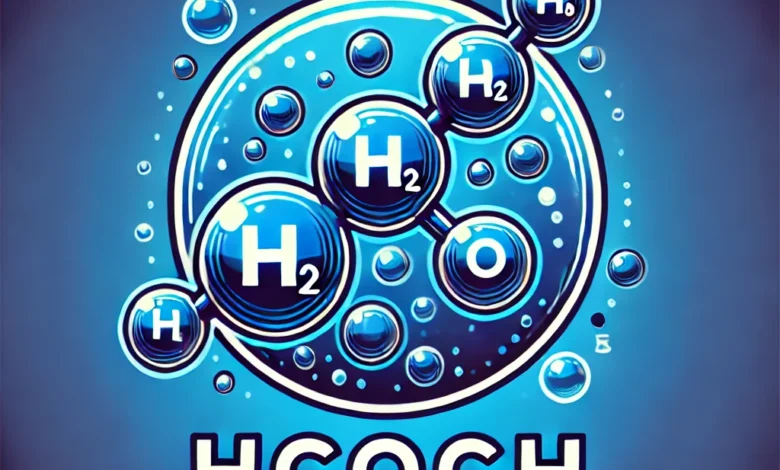Understanding the Chemistry of HCOOCH CH2 H2O

In the world of chemistry, understanding the molecular composition of compounds is fundamental to various applications, from industrial processes to pharmaceuticals. One compound or structure that often arises in organic chemistry is represented by the formula HCOOCH CH2 H2O. This formula seems to depict a combination of chemical functional groups—each with its own significance in organic reactions and material science.
In this article, we will break down this structure to understand what it represents, the possible chemical reactions associated with it, and how it fits into larger fields of chemistry, HCOOCH CH2 H2O such as organic synthesis, biochemistry, and environmental science.
Breaking Down the Formula: HCOOCH CH2 H2O
To better comprehend the formula “HCOOCH CH2 H2O,” we need to divide it into its constituent parts. Each component represents specific atoms or functional groups:
- HCOO: This part of the structure represents a formyl group or formate ester, commonly derived from formic acid (HCOOH).
- OCH: This suggests a simple ether group (-OCH), indicating a bond between oxygen and a carbon atom.
- CH2: This part refers to a methylene group (-CH2), which is a carbon bonded to two hydrogens.
- H2O: This stands for water, a fundamental molecule in many chemical reactions.
Altogether, this molecular structure could be interpreted as an ester or an intermediate in organic chemistry, potentially involved in esterification or hydrolysis reactions.
Formate Ester
The HCOO group indicates an ester derived from formic acid. Esters are a class of compounds that feature a functional group consisting of a carbonyl group (C=O) linked to an alkoxy group (O-C). In this case, HCOO indicates that the ester is a formate, a derivative of formic acid (HCOOH). Formic acid is one of the simplest carboxylic acids, and its derivatives are significant in organic synthesis.
Ether Linkage
The OCH portion suggests that an ether linkage is present. Ethers have the general structure R-O-R’, where R and R’ are alkyl or aryl groups. The presence of the ether linkage indicates that the compound could have a flexible, non-polar character, which is a key property for solvents, biological systems, and organic reactions.
Methylene Group
The CH2 group refers to a methylene unit, which is often found in many organic molecules, especially hydrocarbons, esters, and alcohols. The methylene group provides a bridge for different functionalities and can significantly influence the reactivity of a compound.
Water
Finally, the presence of H2O (water) can play multiple roles in the chemistry of a compound, such as a solvent, reactant, or product in hydrolysis reactions.
Possible Molecular Structures Involving HCOOCH CH2 H2O
While “HCOOCH CH2 H2O” is not a standard chemical formula, it might represent a fragment of a larger molecular structure. Let’s consider a few possible compounds and reactions that this structure could be part of:
Formate Esters in Organic Synthesis
Formate esters like methyl formate (HCOOCH3) or ethyl formate (HCOOC2H5) are used as solvents in organic synthesis. If we hypothesize that “HCOOCH” represents such an ester group, the CH2 part could indicate the presence of an additional functional group like an alcohol or amine group. A potential compound could be a complex ester or ether derivative used as a reagent or an intermediate in chemical reactions.
Hydrolysis Reactions
A formate ester can undergo hydrolysis, a reaction with water, to break the ester bond and yield the corresponding alcohol and formic acid. This reaction is important in both industrial chemistry and biological systems, where ester hydrolysis often takes place under the influence of enzymes (such as esterases) or acidic/alkaline conditions.
In this case, water (H2O) could be a reactant in a hydrolysis reaction, where the ester bond in the molecule is cleaved. This reaction could be useful in producing the desired alcohol and formic acid, both of which have their own uses in industrial applications, such as solvents, preservatives, and fuel additives.
Possible Role in Biochemistry
In biochemistry, molecules resembling this formula could be involved in metabolic pathways, enzyme catalysis, or cellular signaling. For example, formate esters can appear in certain biochemical reactions as intermediates in the degradation or synthesis of larger biomolecules. Furthermore, the methylene group (CH2) could be part of larger coenzymes or organic molecules that play crucial roles in biological functions.
Reactions Involving Formate Esters
Esterification Reactions
Formate esters, like any ester, can be synthesized through esterification reactions. In the esterification process, a carboxylic acid (like formic acid, HCOOH) reacts with an alcohol (such as methanol, CH3OH, or ethanol, C2H5OH) in the presence of a catalyst (often an acid) to form an ester and water. This reaction can be summarized as:HCOOH+ROH→HCOOR+H2OHCOOH + ROH \rightarrow HCOOR + H2OHCOOH+ROH→HCOOR+H2O
where R is any alkyl group. This reaction could involve the esterification of formic acid with methanol to produce methyl formate, a common solvent and reagent in organic synthesis.
Hydrolysis of Esters
As mentioned earlier, esters undergo hydrolysis reactions when exposed to water, which breaks the ester bond and produces an alcohol and an acid. In the case of formate esters, hydrolysis would result in the formation of an alcohol and formic acid:HCOOR+H2O→HCOOH+ROHHCOOR + H2O \rightarrow HCOOH + ROHHCOOR+H2O→HCOOH+ROH
This reaction is reversible under certain conditions and can be used in both industrial applications and laboratory synthesis.
Alcoholysis of Formate Esters
Another important reaction involving formate esters is alcoholysis. In this reaction, an ester reacts with an alcohol to form a different ester. For example, methyl formate (HCOOCH3) could undergo alcoholysis with ethanol (C2H5OH) to produce ethyl formate (HCOOC2H5) and methanol (CH3OH):HCOOCH3+C2H5OH→HCOOC2H5+CH3OHHCOOCH3 + C2H5OH \rightarrow HCOOC2H5 + CH3OHHCOOCH3+C2H5OH→HCOOC2H5+CH3OH
This reaction is important in industries that produce various esters for flavors, fragrances, and other chemicals.
Applications of Formate Esters and Related Compounds
Industrial Applications
Formate esters are widely used in the chemical industry as solvents, plasticizers, and intermediates in the production of various chemicals. They are often employed in the manufacture of coatings, adhesives, and as chemical reagents in synthetic reactions.
Additionally, formic acid and its esters play significant roles in agricultural and food processing industries. Formic acid, in particular, is used as a preservative, antimicrobial agent, and feed additive in livestock farming.
Pharmaceutical and Biochemical Applications
Formate esters and their derivatives can also be found in pharmaceutical applications. For example, formic acid and certain esters may act as intermediates in the synthesis of bioactive compounds, antibiotics, or other therapeutic molecules. The reaction pathways involving formates could also be important in the design of prodrugs, which are compounds that are metabolized into their active form inside the body.
Environmental Considerations
Water’s presence in reactions involving esters is not only essential for their reactivity but also for environmental considerations. Hydrolysis reactions that degrade formate esters in natural water bodies may affect water quality and contribute to pollution. Understanding the degradation pathways of such compounds is important for assessing their environmental impact.
Conclusion
In conclusion, while “HCOOCH CH2 H2O” is not a common standalone formula, it likely represents a part of a more complex structure that plays a role in organic chemistry, biochemistry, and industrial chemistry. Formate esters, their hydrolysis, and the influence of water molecules all form a crucial part of chemical processes in many areas, from pharmaceuticals to environmental sciences. By understanding the various reactions and applications of formate esters, we gain deeper insights into their versatility and importance in both academic and industrial contexts.
Further research into these reactions and molecules could open doors to innovative solutions in areas like drug design, sustainable chemical processes, and environmental remediation.



